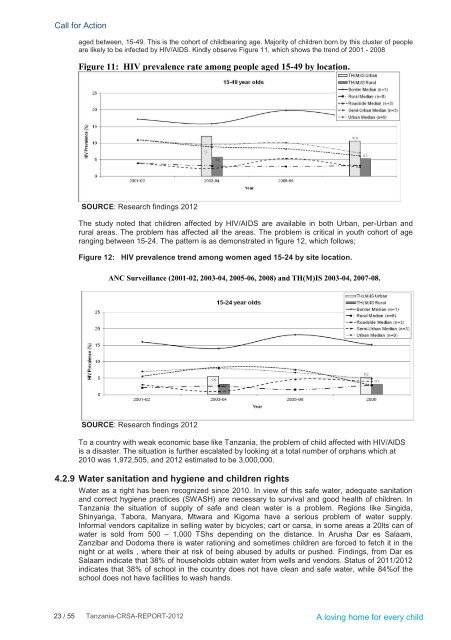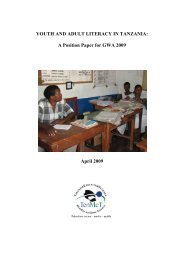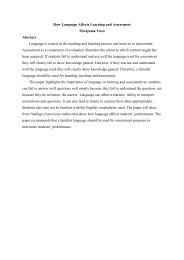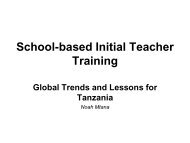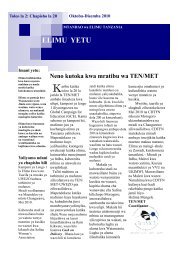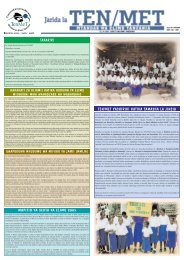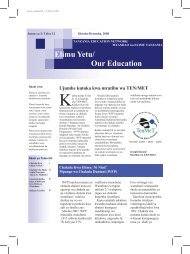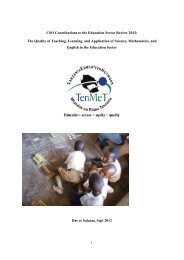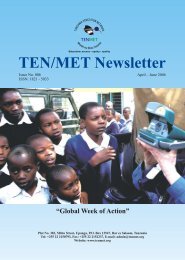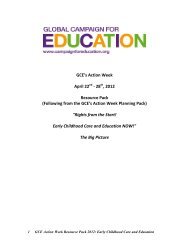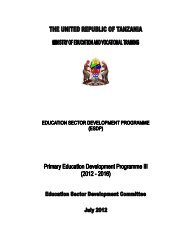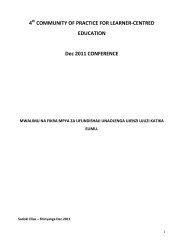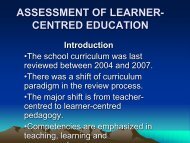Status of Children in Tanzania - 2012 - Tanzania Education Network ...
Status of Children in Tanzania - 2012 - Tanzania Education Network ...
Status of Children in Tanzania - 2012 - Tanzania Education Network ...
Create successful ePaper yourself
Turn your PDF publications into a flip-book with our unique Google optimized e-Paper software.
Call for Action<br />
aged between, 15-49. This is the cohort <strong>of</strong> childbear<strong>in</strong>g age. Majority <strong>of</strong> children born by this cluster <strong>of</strong> people<br />
are likely to be <strong>in</strong>fected by HIV/AIDS. K<strong>in</strong>dly observe Figure 11, which shows the trend <strong>of</strong> 2001 - 2008<br />
Figure 11: HIV prevalence rate among people aged 15-49 by location.<br />
SOURCE: Research f<strong>in</strong>d<strong>in</strong>gs <strong>2012</strong><br />
The study noted that children affected by HIV/AIDS are available <strong>in</strong> both Urban, per-Urban and<br />
rural areas. The problem has affected all the areas. The problem is critical <strong>in</strong> youth cohort <strong>of</strong> age<br />
rang<strong>in</strong>g between 15-24. The pattern is as demonstrated <strong>in</strong> figure 12, which follows;<br />
Figure 12: HIV prevalence trend among women aged 15-24 by site location.<br />
ANC Surveillance (2001-02, 2003-04, 2005-06, 2008) and TH(M)IS 2003-04, 2007-08.<br />
SOURCE: Research f<strong>in</strong>d<strong>in</strong>gs <strong>2012</strong><br />
To a country with weak economic base like <strong>Tanzania</strong>, the problem <strong>of</strong> child affected with HIV/AIDS<br />
is a disaster. The situation is further escalated by look<strong>in</strong>g at a total number <strong>of</strong> orphans which at<br />
2010 was 1,972,505, and <strong>2012</strong> estimated to be 3,000,000.<br />
4.2.9 Water sanitation and hygiene and children rights<br />
Water as a right has been recognized s<strong>in</strong>ce 2010. In view <strong>of</strong> this safe water, adequate sanitation<br />
and correct hygiene practices (SWASH) are necessary to survival and good health <strong>of</strong> children. In<br />
<strong>Tanzania</strong> the situation <strong>of</strong> supply <strong>of</strong> safe and clean water is a problem. Regions like S<strong>in</strong>gida,<br />
Sh<strong>in</strong>yanga, Tabora, Manyara, Mtwara and Kigoma have a serious problem <strong>of</strong> water supply.<br />
Informal vendors capitalize <strong>in</strong> sell<strong>in</strong>g water by bicycles; cart or carsa, <strong>in</strong> some areas a 20lts can <strong>of</strong><br />
water is sold from 500 – 1,000 TShs depend<strong>in</strong>g on the distance. In Arusha Dar es Salaam,<br />
Zanzibar and Dodoma there is water ration<strong>in</strong>g and sometimes children are forced to fetch it <strong>in</strong> the<br />
night or at wells , where their at risk <strong>of</strong> be<strong>in</strong>g abused by adults or pushed. F<strong>in</strong>d<strong>in</strong>gs, from Dar es<br />
Salaam <strong>in</strong>dicate that 38% <strong>of</strong> households obta<strong>in</strong> water from wells and vendors. <strong>Status</strong> <strong>of</strong> 2011/<strong>2012</strong><br />
<strong>in</strong>dicates that 38% <strong>of</strong> school <strong>in</strong> the country does not have clean and safe water, while 84%<strong>of</strong> the<br />
school does not have facilities to wash hands.<br />
23 / 55 <strong>Tanzania</strong>-CRSA-REPORT-<strong>2012</strong><br />
A lov<strong>in</strong>g home for every child


